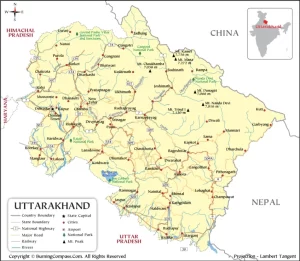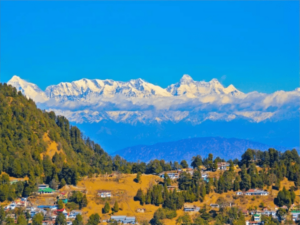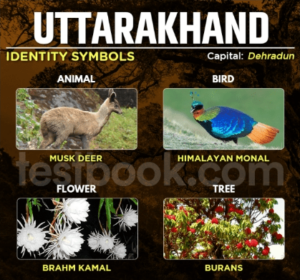About Uttarakhand
Uttarakhand, a northern state in India, is a land of unparalleled beauty, where the majestic Himalayas stand tall as guardians of nature and spirituality. Known as “The Land of Gods” (Devbhoomi), Uttarakhand is a state rich in natural resources, culture, and history. Its awe-inspiring landscapes, ranging from towering peaks to lush valleys, serene rivers to dense forests, make it one of the most revered and visited destinations in India.
Geography and Natural Beauty

Uttarakhand is bordered by Uttar Pradesh to the south, Himachal Pradesh to the west, and the international border with China (Tibet) to the north. The state is divided into two main regions: Garhwal and Kumaon, each offering distinct geographical features. Garhwal is home to the towering peaks of Nanda Devi, Trishul, and Kedarnath, while Kumaon is known for its lakes, including the serene Naini Lake in Nainital, and the forests of Corbett National Park, India’s oldest wildlife sanctuary.
The state’s terrain is characterized by lush green hills, alpine meadows, deep river valleys, and expansive forests. The Ganges and Yamuna, two of India’s most sacred rivers, originate from the state, making Uttarakhand a significant spiritual and ecological hub.

Cultural Heritage and Spiritual Significance
Uttarakhand is deeply rooted in religious and cultural traditions. The state’s historical and spiritual importance is amplified by the Char Dham Yatra, which includes the revered shrines of Yamunotri, Gangotri, Kedarnath, and Badrinath. These pilgrimage sites attract millions of devotees from across the world, especially during the peak pilgrimage season. The Kumbh Mela, one of the largest religious gatherings globally, is held in Haridwar, a city that lies in the foothills of Uttarakhand, every 12 years.
Beyond its spiritual significance, Uttarakhand is a place where traditional arts and crafts thrive. The state’s festivals, such as Nanda Devi Mela, Makar Sankranti, and Baisakhi, are celebrated with great zeal and fervor. The folk dances like Langvir and Chholiya, as well as the music and local craftsmanship, are integral parts of its cultural identity.
Flora and Fauna
The diverse geographical terrain of Uttarakhand has created a unique habitat for a rich variety of flora and fauna. The state boasts of several national parks and wildlife sanctuaries, such as Jim Corbett National Park, Rajaji National Park, and Nanda Devi Biosphere Reserve, which are home to many endangered species, including the Bengal tiger, leopard, and snow leopard. The forest cover, consisting of oak, deodar, rhododendron, and pine, is a testament to the state’s ecological wealth.

Economy and Livelihoods
Agriculture remains a vital part of Uttarakhand’s economy. The fertile lands of the Terai region are used for farming crops such as rice, wheat, and sugarcane. In the hilly areas, people primarily grow fruit like apples, apricots, and almonds. In addition, the state is known for its herbal products and handloom industries, which produce traditional woolen clothes and handicrafts. However, due to its tough terrain, agriculture in the region can be challenging, and many people have migrated to urban areas in search of employment.
Tourism, particularly religious and eco-tourism, plays a significant role in the state’s economy. With its lush green landscapes, sacred sites, and adventure tourism opportunities such as trekking, white-water rafting, and camping, Uttarakhand continues to draw millions of tourists each year. However, the influx of tourists also presents challenges in terms of infrastructure, sustainability, and conservation.
Challenges and Opportunities
Despite its natural beauty and spiritual significance, Uttarakhand faces several socio-economic challenges. Poverty remains a major issue, particularly in remote rural areas where access to basic services such as healthcare, education, and employment opportunities is limited. Climate change has also impacted the region, with erratic rainfall patterns, glacial retreat, and landslides becoming more frequent. The 2013 floods were a devastating example of how natural disasters can disrupt lives and communities in the state.
To address these challenges, various government and non-government initiatives are working towards improving the lives of the people. Organizations like Sabri Human Welfare Trust® play a crucial role in providing healthcare, education, and supporting community development in underserved areas. Through these efforts, the state is slowly progressing toward overcoming its challenges.
Sustainable Development and Conservation Efforts
Uttarakhand’s rich biodiversity and fragile ecosystem require sustainable development efforts to balance the needs of economic growth with environmental conservation. The government has implemented various policies and projects to promote eco-tourism, reforestation, and water conservation. Local communities are being encouraged to adopt environmentally-friendly practices such as organic farming and sustainable tourism. The focus is also on promoting renewable energy solutions, such as hydroelectric power, which is abundant in the region due to its many rivers and streams.
Conclusion
Uttarakhand is a state of contrasts – where spirituality meets adventure, where ancient traditions coexist with modern development, and where nature’s raw beauty remains unspoiled despite the challenges of progress. It is a place of immense potential, and with the efforts of both the government and NGOs like Sabri Human Welfare Trust®, Uttarakhand is on its way to creating a sustainable and prosperous future for its people while preserving its rich heritage and natural wealth.
Whether you’re here for spiritual solace, an adventure in the Himalayas, or to experience the vibrant culture, Uttarakhand offers something for everyone. Its people, its landscapes, and its divine aura make it a truly unique and unforgettable part of India.

